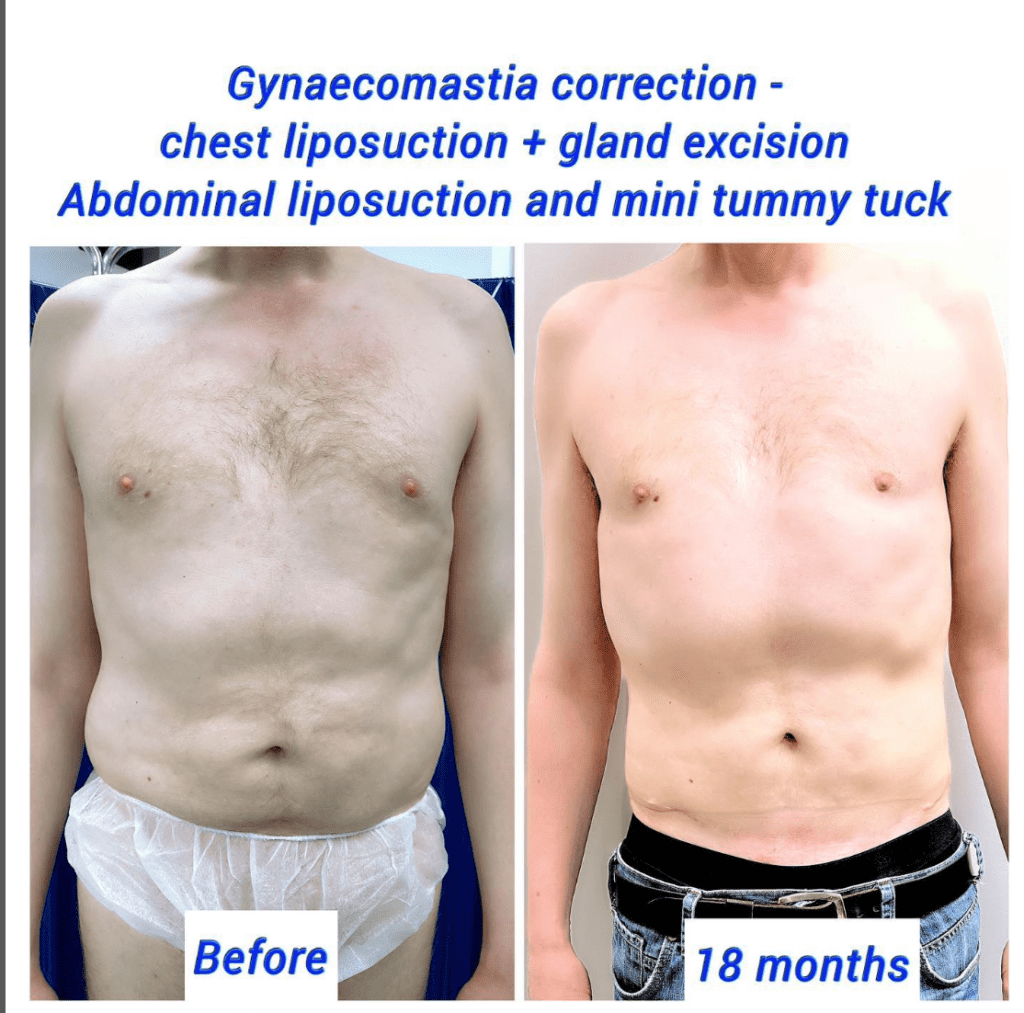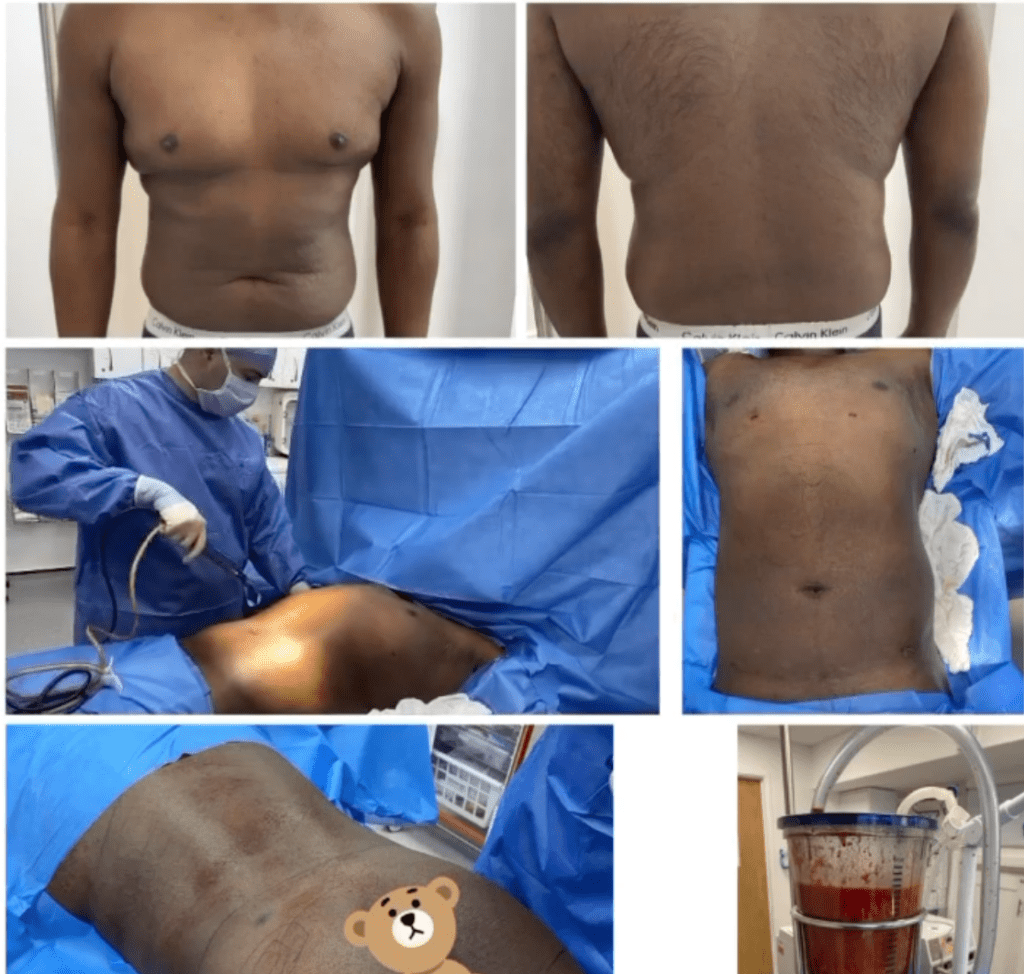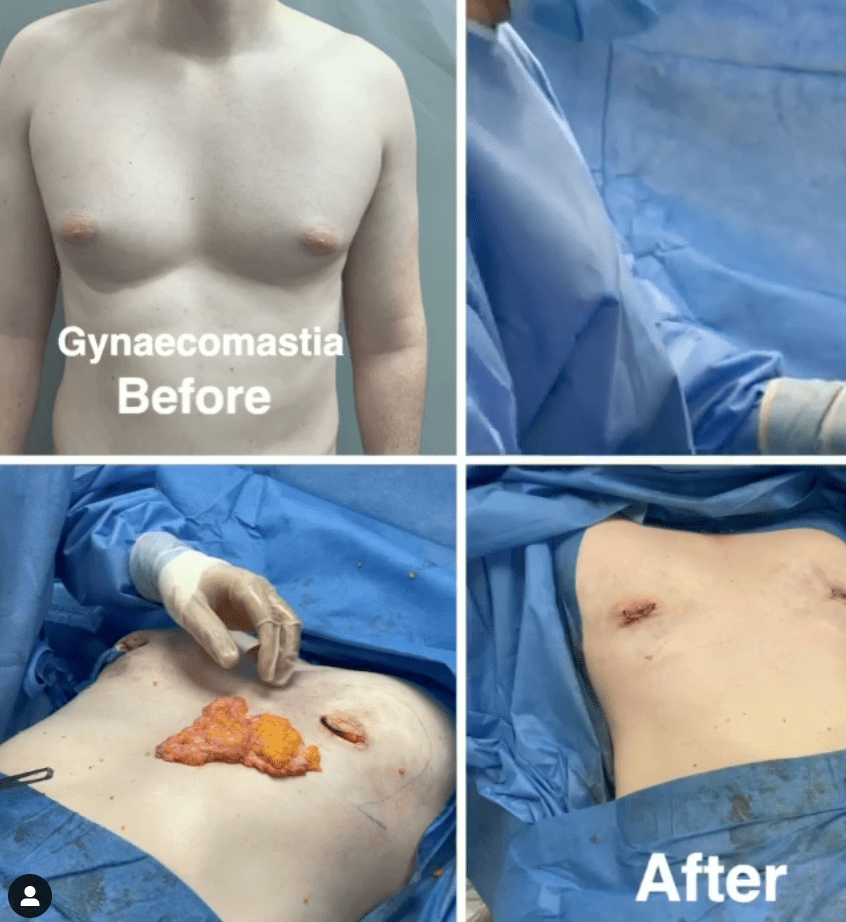Gynaecomastia is a condition that affects boys and men. It’s sometimes referred to as ‘man boobs’. Although it’s not usually a serious medical condition, it can be tough to live with. Often, it causes embarrassment and really impacts self-esteem and confidence. Let’s take a look at what it is, and how you can treat gynaecomastia.
What is Gynaecomastia?
The condition, pronounced guy-nee-co-mastia, is most common in boys and older men but can affect adult men too. It refers to an increase in the amount of tissue in the breast gland. Gynaecomastia can affect either one or both breasts and give an uneven appearance. You may notice extra tissue around the nipples and more prominent breasts. Sometimes, patients also experience pain in the breast.
Gynacomastia is a common condition that’s benign (not cancer). Despite it being common, it’s often not talked about that much. People with gynaecomastia can feel self-conscious and anxious about their appearance.
Gynaecomastia may go away on its own, but as it’s breast gland tissue and not fat, it’s not something that tends to respond to exercise or diet in the same way as weight loss. In general, it’s not a serious medical problem, but it can lead to feelings of embarrassment, especially when shirtless or going swimming.
Chest Fat vs Gynaecomastia
In general, chest fat is soft to the touch. Whereas gynaecomastia should feel firmer. If you have chest fat, then losing weight should reduce the size of the fat. However, if you have gynaecomastia, it won’t go away with exercise and diet alone.
Here are some of the differences between chest fat vs gynaecomastia:
Chest fat:
- Feels softer
- No pain or tenderness
- May have some breast sagging
- The breast may look bigger
Gynaecomastia symptoms include:
- Puffy nipples
- Pain and tenderness
- May feel a lump below the nipple area
- Enlargement of one or both breasts
There are different stages of gynaecomastia. It can range from mild symptoms to much more severe signs of the condition. For more insight, we’ve pulled together a guide on how to spot the symptoms of severe gynaecomastia.

What Causes Gynaecomastia?
It’s thought that changes in hormones are often at the root of the problem when there’s an imbalance between the sex hormones testosterone and oestrogen. Although the condition may come from a hormonal imbalance, it’s not always possible to find the cause of the imbalance in the first place.
Gynaecomastia actually occurs naturally at different times throughout life because of normal hormonal changes, such as after birth, at puberty, and between the ages of 50 and 80. There are several health conditions and certain medications that may also cause gynaecomastia, including:
- Obesity
- Health conditions such as liver or kidney disease
- Extreme stress
- Hyperthyroidism
- Certain medications
There are some medications or drugs associated with the onset of gynaecomastia. Drugs causing gynaecomastia may include:
- Growth hormones
- Anabolic steroids
- Amphetamines
- Excessive Alcohol
How is Gynaecomastia Diagnosed?
In most cases, your doctor should be able to diagnose the condition on site. However, sometimes, your doctor may refer you to a specialist doctor or nurse for a breast examination. This could include a mammogram or a core biopsy of the breast tissue. Because gynaecomastia can be a symptom of another condition, your doctor may examine other areas of the body as well as the breasts.
Gynaecomastia Treatment
Often, enlarged breasts are bothersome and can severely affect your confidence. Gynaecomastia may go away on its own. For younger boys, it tends to go away after puberty. The condition may go away with changes to medications. Your doctor may also suggest taking medications to adjust a hormonal imbalance.
However, if the condition doesn’t resolve on its own, you can treat it with specialist surgery. If the condition isn’t improving or it’s causing a lot of tenderness, pain, or embarrassment, then surgery may be necessary.
What is Gynaecomastia Surgery?
During male breast reduction surgery, your surgeon will remove excess breast glandular and fatty tissue from the breasts. This will result in a more masculine and defined chest.
The procedure takes up to an hour and uses small incisions under the arms to remove the excess tissue. Your doctor will remove excess tissue either through male liposuction or using a scalpel. Your nipples may be repositioned as well.
It’s a good idea to take up to one week off work to recover. Although you will be up and about the same day as the surgery, you can return to normal activities and exercise in about three weeks.
After your surgery, you need to give your body time to heal. As you start to work out after male breast reduction surgery, keep in mind that you may need to avoid heavy weights in the beginning. At about 6 weeks, you can start doing light chest and arm exercises. You will likely need to build up your strength gradually. As you get stronger, introduce free weights back into your routine.
It’s common to experience some bruising and swelling after surgery. This is entirely normal. You can expect to see the final results in roughly six months. After treatment, the gynaecomastia won’t return as your surgeon will remove the gland during surgery.
During gynaecomastia recovery, you will need to wear a compression garment. It will look like a vest and its job is to support the breasts and compress the chest at the same time. Normally, you wear a compression vest for about 4-6 weeks. It can take a little while to get used to it, but it’s essential for optimal results.
Gynaecomastia Q & A
Does Gynaecomastia Go Away?
In most cases, gynaecomastia goes away by itself. However, different treatments are often offered in cases where the condition is persistent. These treatment options include surgery to remove the excess breast tissue, for example, male breast reduction surgery and male liposuction.
What is the Most Common Cause of Gynaecomastia?
Obesity is a common cause of gynaecomastia. This is because being overweight increases estrogen levels, which can cause the breast tissue to grow beyond normal. Additionally, obesity increases the possibility of having excess fat, which can also contribute to the enlargement of breast tissue. Other common causes include the hormonal imbalance of testosterone and estrogen hormones.
Is Gynaecomastia Cancer?
No, it is not cancer, but rather an increase in the amount of a man’s breast tissue. Research studies indicate that cancers are diagnosed in only about 1% of cases of gynaecomastia. Therefore, male breast enlargement is not an indication of cancer. Additionally, various treatment approaches are available and recommended by a doctor after consultation.
How Do You Fix Gynaecomastia?
Although it is one of the conditions that contribute to the number of men undergoing cosmetic surgery globally, different treatment approaches are recommended to fix gynaecomastia. These include:
- Surgery: including liposuction, which involves the removal of fat but not the breast gland, and mastectomy, which consists of the removal of the breast gland tissue.
- Healthy lifestyle changes such as regular exercise and diet may help.

Is it Possible to Reduce Male Breast Size?
Yes, it is possible to reduce male breast size. For conditions such as gynaecomastia, the male breasts may return to their normal sizes over time. However, in situations where the male breast size persistently remains enlarged, then you may consult your doctor on the most effective treatment option. This ensures that you remain healthy throughout and after the process.
Can You Reduce Male Breast Size Without Surgery?
Yes, you can sometimes reduce male breast size without surgery. This can be achieved through the use of non-surgical therapies to treat gynaecomastia. These include:
- Dieting and exercising
- Hormone treatments
- Losing weight
- Reducing alcohol intake
- Stop using certain drugs and steroids that can increase the risk of developing the condition.
Depending on the cause of gynaecomastia, non-surgical methods may help, but you will need to speak with a doctor for a proper diagnosis and treatment plan.
How Long Does it Take to Recover From Male Breast Reduction?
It takes about six weeks to recover from male breast reduction surgery. However, within the first two weeks, you should start to feel like yourself again. In order to ensure that you fully recover from the procedure, it is important to follow your doctor’s recommendations to avoid any complications that may delay the recovery.
What are the Symptoms of Gynaecomastia?
Gynaecomastia is characterised by various symptoms, including:
- The presence of a lump beneath the nipple, which may be painful to touch.
- Enlargement of the breasts unevenly
- Breast tenderness
- A sensitive nipple
- Swollen breast tissue
What Does a Male Breast Lump Feel Like?
A breast lump in men primarily occurs if you have gynaecomastia. In this case, it feels hard and often different from the rest of the breast tissue. It may also be a sign of other conditions such as breast cancer, so it is important to consult your doctor if you notice a lump.
Before and After Male Breast Reduction Surgery

Although it’s normal to experience changes in hormones as you get older, changes in these areas can make you feel self-conscious and impact other areas of your life. If you’re unhappy with your chest’s appearance and find that it affects your confidence, male breast reduction may be an excellent solution for you.
Would you like a consultation for this procedure? Contact us, and we will find the best plan of treatment for you.













